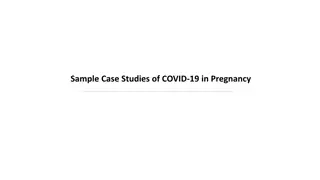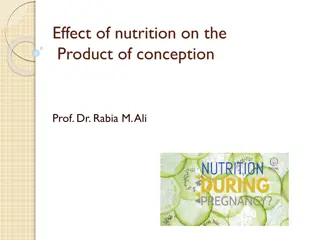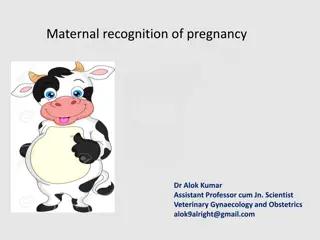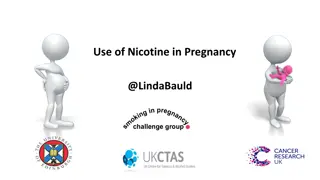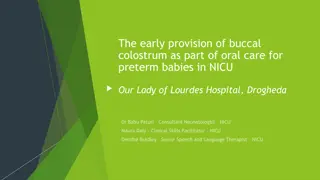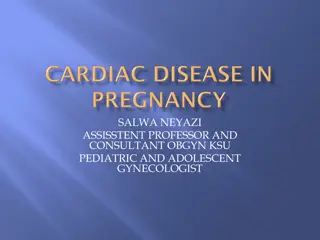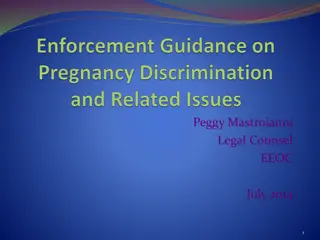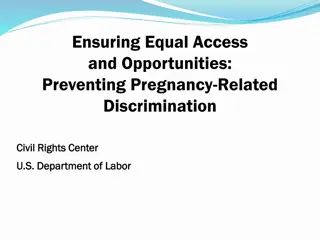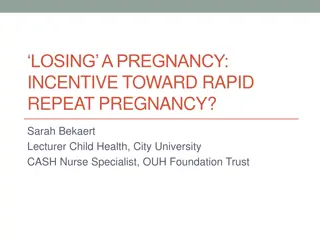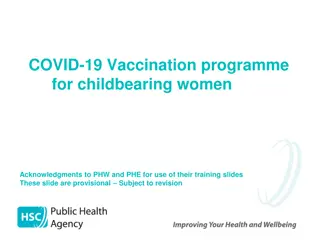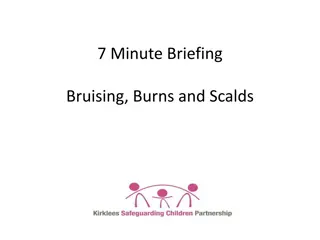Precaution Measures for COVID-19 in Pregnancy: Protecting Women and Babies
Pregnant women are more susceptible to COVID-19 and may face severe illness. Limited data suggest potential risks including adverse neonatal outcomes. It is crucial to follow precautionary measures to protect women during pregnancy, labor, postnatal, and lactation stages.
Download Presentation

Please find below an Image/Link to download the presentation.
The content on the website is provided AS IS for your information and personal use only. It may not be sold, licensed, or shared on other websites without obtaining consent from the author. Download presentation by click this link. If you encounter any issues during the download, it is possible that the publisher has removed the file from their server.
E N D
Presentation Transcript
Precaution Measures for Covid 19 Infection Control for women during Pregnancy , labor, Postnatal, & Lactation.
Introduction: Many studies in Pregnant women with COVID-19 have indicated few maternal and neonatal complications, but more concrete evidence is required as these studies involved a small number of women over a short period. Importantly, viral respiratory illnesses, such as influenza, can easily pregnancy, which means pregnant women may be more vulnerable to COVID-19 and require prioritized medical care. develop during
Coronavirus (COVID-19) Is an illness caused by a virus that can spread from person to person. The virus that causes COVID-19 is a new coronavirus that has spread throughout the world. COVID-19 symptoms can range from mild (or no symptoms) to severe illness.
How is COVID-19 spread? COVID-19 likely emerged from an animal source but now is spreading from person to person. Human coronaviruses most commonly spread from an infected person to others through a variety of means, such as airborne droplets from coughing and sneezing; close personal contact, including touching and shaking hands; Touching one s nose, mouth, or eyes before washing hands. It is currently unknown if the virus can be spread through semen or sexual intercourse. COVID-19 may be spread by people who are not showing symptoms. person can get COVID-19 by touching a surface or object that has the virus on it At this time, the risk of COVID-19 spreading from animals to people is considered to be low COVID-19 can spread from people to animals in some cases
What is known about COVID-19 in pregnancy? Currently, there is limited information from published scientific reports about the susceptibility of pregnant women to COVID-19 and the severity of infection. Available data are reassuring but are limited to small case series. In general, pregnant women experience immunologic and physiologic changes that make them more susceptible to viral respiratory infections, including potentially COVID-19. It is reasonable to predict that pregnant women might be at greater risk for severe illness, morbidity, or mortality compared with the general population, as is observed with other related coronavirus infections [including severe acute respiratory syndrome coronavirus (SARS-CoV) and Middle East respiratory syndrome coronavirus (MERS-CoV)], and other viral respiratory infections, such as influenza, during pregnancy.
Covie19 in pregnancy may be associated with severe infection and adverse neonatal outcomes, including: increased risk of miscarriage, fetal growth restriction, and preterm birth low birth weight clotting and blood problems.
Symptoms may appear 2-14 days after exposure to the virus. People with these symptoms may have COVID-19: Fever or chills Cough Shortness of breath or difficulty breathing Fatigue Muscle or body aches Headache New loss of taste or smell Sore throat Congestion or runny nose Nausea or vomiting Diarrhea
Emergency warning signs for COVID-19 include; Trouble breathing Persistent pain or pressure in the chest New confusion Inability to wake or stay awake Bluish lips or face
Are there delivery considerations? For women infected early in pregnancy who recover, no alteration to the usual timing of delivery is necessary. For women infected in the third trimester who recover, it is reasonable to attempt to postpone delivery (if no other medical indications arise) either until a negative testing result, to avoid transmission to the neonate. In general, COVID-19 infection itself is not an indication for delivery.
Can an infected woman breastfeed? There is no evidence of COVID-19 in the breast milk of infected women. Breastfeeding is encouraged and is a potentially important source of antibody protection for the infant. The CDC recommends that during temporary separation, women who intend to breastfeed should be encouraged to express their breast milk to establish and maintain milk supply. If possible, a dedicated breast pump should be provided. Before expressing breast milk, women should practice appropriate hand hygiene. After pumping, all parts of the pump that come into contact with breast milk should be thoroughly washed, and the entire pump should be appropriately disinfected. Expressed breast milk should be feed to the newborn by a healthy caregiver. For women and infants who are not separated, and the woman wishes to feed at the breast, she should put on a facemask and practice hand hygiene before each feeding
Measures for Pregnant Women to Prevent COVID-19 infection The greatest tool to prevent COVID-19 Infection in the general population and for pregnant women is Social Distancing, such as: there is a non-pharmaceutical infection prevention and control intervention implemented to avoid/decrease contact between those who are infected with a disease/pathogen and those who are not, Disinfection of surfaces to reduce fomites related spread. For women working outside the house, it is preferable to take Work from Home. Keeping a distance of at least one meter in various necessary interactions and activities, If public transport is used, distance should be maintained. Minimize visitors from coming to meet the mother and newborn after delivery.
Stay at home as much as possible unless there is a medical need related to development of symptoms of infection or related to pregnancy. Routine antenatal visits are to be deferred. If there is a minor query, it can be Washing their hands frequently and properly with a soap and water or an alcohol for minimum 20 seconds Covering their mouth and nose with their bent elbow, or tissue while coughing or sneezing. Then the used tissue should be disposed immediately. Avoid touching face, eyes, nose and mouth with hands. wearing a surgical mask and changing it every 6 to 8 hours. Disposable gloves should be used Clothes should be washed separately
Call midwife or maternity team immediately if: the baby is moving less than usual cannot feel the baby moving there is a change to baby usual pattern of movements have any bleeding from the vagina feeling very anxious or worried have a headache that does not go away if shortness of breath when resting or lying down
Clinical Presentation of COVID-19 in Pregnancy The mean incubation period (from exposure to the appearance of clinical features) is 5 to 7 days. Most people who are infected will show features latest by 11 days of exposure which include: . Most pregnant women will have mild to moderate flu-like symptoms of cough, sore throat, and fever. Few may have difficulty in breathing or shortness of breath. These have been classified as severe acute respiratory illness (SARI) by the WHO. Pregnant women, especially those with associated medical diseases (diabetes, asthma, etc) may present with pneumonia and hypoxia. elderly pregnant women may present with atypical symptoms such as fatigue, malaise, body ache and/or gastrointestinal symptoms like nausea and diarrhea.
Actions should be taken for pregnant: Do not skip the prenatal care time. Limit interactions with other people as much as possible. Take precautions to prevent getting COVID-19 when do interact with others. Talk to her healthcare provider about how to stay healthy and take care of yourself during the COVID-19 pandemic. If she don t have a healthcare provider, contact nearest community health center or health department. Call the healthcare provider if she has any questions related to baby health. take care immediately if she has a medical emergency. pregnant may feel increased stress during this pandemic, and increase anxiety. Learn about stress and coping. Learn more about how to reduce the risk of getting COVID-19.
Testing for COVID-19 in Pregnancy Indications (Criteria) The criteria for offering a laboratory test are the same for pregnant women and the non-pregnant population. Currently pregnant women should be tested in the following circumstances: 1. A pregnant woman who has acute respiratory illness 2. A pregnant woman who is presently asymptomatic should be tested between 5 and 14 days of coming into direct. Investigations include: X-Ray is taken or a CT scan is needed for a pregnant woman, there should be provision of an abdominal shield to protect the fetus from radiation exposure. polymerase chain reaction (PCR)
Effects of COVID-19 infection on mother health: If the pregnant woman has co-morbid conditions such as: diabetes, hypertension, obesity, respiratory disease or is of advanced age, she is more likely to have a severe form of respiratory disease
Medical management and drugs used in the treatment of COVID-19 infection in pregnancy Supportive therapy for COVID-19 infections should include rest, oxygen supplementation, fluid management nutritional care as needed. The treatment of COVID-19 viral infection has been attempted by two approaches. The first approach is the use of a combination of Azithromycin and Hydroxychloroquine. The other approach has been to use antiviral drugs, which include: Hydroxychloroquine in a dose of 600 mg, and Azithromycin (500 mg once a day) Antiviral therapy Vaccine Other Drugs Like
Paracetamol is the preferred drug. If possible, Ibuprofen. Antenatal Steroids (fetal maturity Antihypertensives Antibiotics: If there is a suspicion of secondary bacterial infection, Oxygen: If there is difficulty in breathing, nasal oxygen at 4 to 6 liters per minute should be immediately administered. Noninvasive ventilation can also be used.
Intensive Care Management for pregnant woman: The principle evidence-based guidelines for ARDS include: Conservative Intravenous fluid strategies early antibiotic for possible bacterial pneumonia Early invasive ventilation may be needed Lung protective ventilation strategies Periodic prone positioning during mechanical ventilation Extracorporeal membrane oxygenation where needed
For women wishing to breastfeed, the following precautions should be taken to limit spread corona virus to the baby: Pregnant woman should wash her hands before and after touching her baby, Mother should practice respiratory hygiene by wearing a mask and not sneezing in front of a baby during breast feeding All surfaces should be kept clean and disinfect she has touched If a mother is confirmed with COVID-19 infection and wishes expressing breast milk can use a manual or electric breast pump
the mother should follow recommendations for proper pump cleaning after each use. The woman should use private transport or an ambulance when possible to reach the maternity unit. Keep the room free from any unnecessary items (decorations, extra chairs,) There should be a restriction on the number of attendants allowed with the woman and all precautions should be taken.
Risk factors for hospital admission with COVID-19 infection in pregnancy 1. Black, Asian or minority ethnicity (BAME). 2. Overweight or obesity. 3. Pre-existing comorbidity. 4. Maternal age >35 years.
Neonatal care and family advice for the baby borne from infected women: Women and their healthy babies, should be kept together in the immediate postpartum period. infected Women should be supported and can be remain together with their babies and to practice skin- to-skin/kangaroo care, if the newborn does not require additional medical care at this time. infected or suspected Women should be supported to breastfeed if they choose. Specific guidance on neonatal resuscitation during the COVID-19 pandemic is available Families should be supported in their feeding choices and informed of the risks and benefits of feeding the baby.





